1lumen selects and reviews products personally. We may earn affiliate commissions through our links, which help support our testing.
Note: some of the images in this review are taken from the previous version.
Sofirn SP36 Pro Anduril2 Review
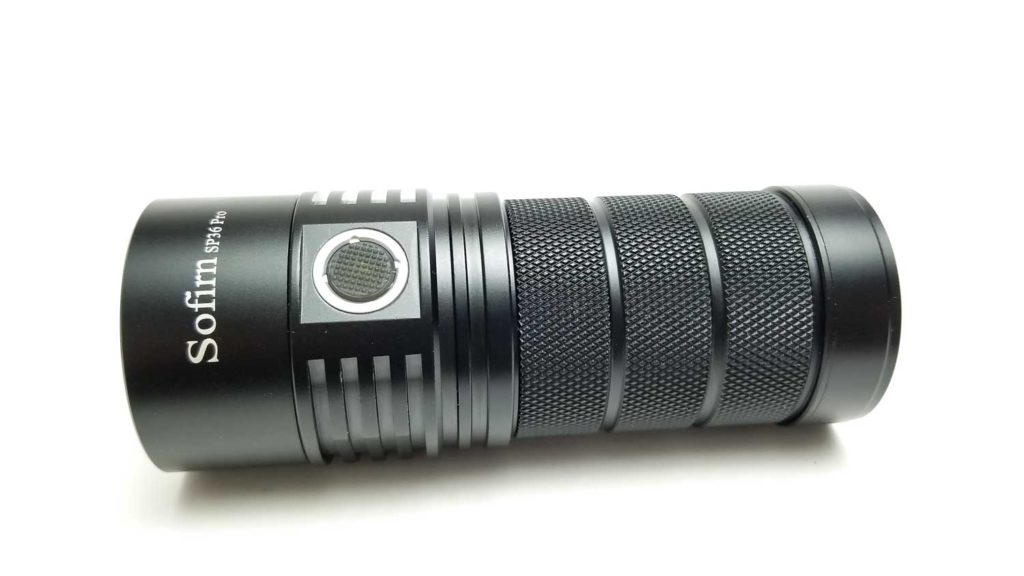
Sofirn SP36 Pro Anduril 2 specifications
| Brand/model | Sofirn SP36 Pro Anduril 2 |
|---|---|
| LED | Luminus SST40 |
| Max. Lumens | 8000 Lumens |
| Max. Beam intensity | ? cd |
| Battery config. | 3*18650 |
| Onboard charging | USB-C |
| Modes | Many! Anduril 2 |
| Blinkies | Many |
| Reflector | Quad SMO |
| Waterproof | IPX8 |
| Review date | February 2022 |
Introduction:
When I reviewed the original Sofirn SP36 Pro back in 2021, my synopsis was that it’s a nice, versatile light, representing a nice upgrade from the OG BLF Q8. It more or less retained the Q8’s output and added niceties like onboard charging and a slimmer form factor. Oh, and let’s not forget that you get everyone’s favorite fantasy action-adventure-sword UI, Anduril. However, we know the wheels of progress must keep rolling, so now there’s a new SP36 Pro. Well, not entirely new since it’s basically an SP36 Pro with some electronic tweaks. What did Sofirn tweak? If you guessed a new UI, well give yourself a high five because Sofirn gave it both a new driver and Anduril2, along with another enhancement. I already reviewed this light, so some of this might seem a bit redundant, but let’s dig in and see if Sofirn surprises me with some unintentional features.
Package quality.
Sofirn doesn’t invest heavily in packaging and the SP36 isn’t sold in retail stores, so the boxes are, well, pretty much boxes and not much else. The SP36 Pro arrived in the familiar recycled cardboard box with Sofirn on the top, some QR codes on the bottom, and a single sticker with the emitter CCT on it. That’s it. No fanfare or fufu packaging. Inside, the SP36 was wrapped in protective bubble wrap and the bottom of the box was cushioned with foam. No damage whatsoever, so a win for the packaging. Here’s what you get:
- Sofirn SP36 Pro flashlight
- USB A to C charging cable
- 2 spare o-rings
- 3 Sofirn-branded 18650 button top batteries (loaded in the light)
- User manual
The batteries are part of the ‘kit’ option, and the test light came with Sofirn-branded 3000 mAh 18650s. If you don’t have 3 matching batteries, it’s a good idea to get them because it’s way cheaper than buying them separately. The included accessories are high quality, and it’s nice to see Sofirn’s still including their excellent quality USB cable. The cells were loaded in the light the right side up this time, and there was a paper isolator to keep them from dumping during storage. The included user guide is pretty thorough and will help you negotiate the eccentricities of Anduril2.
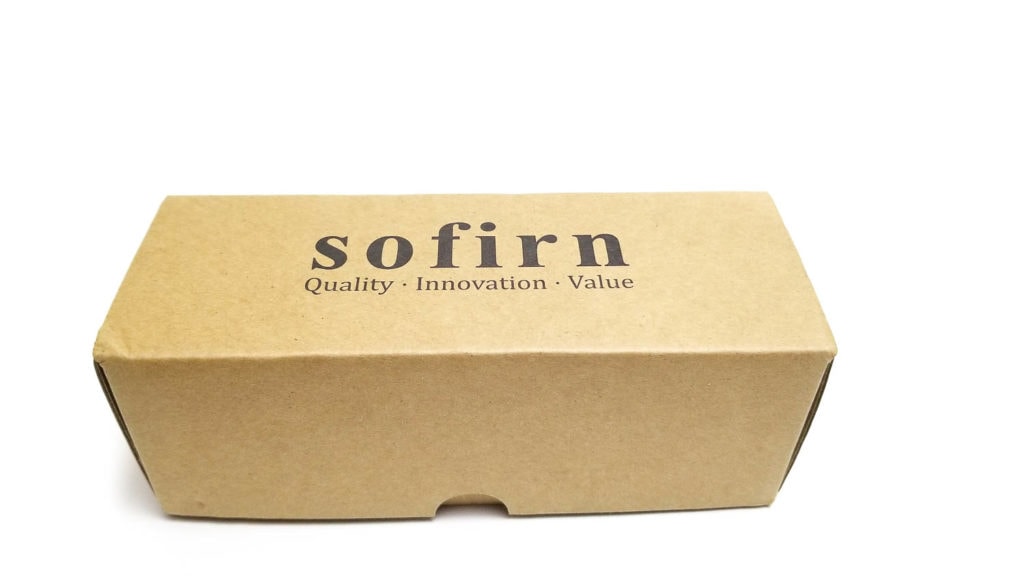
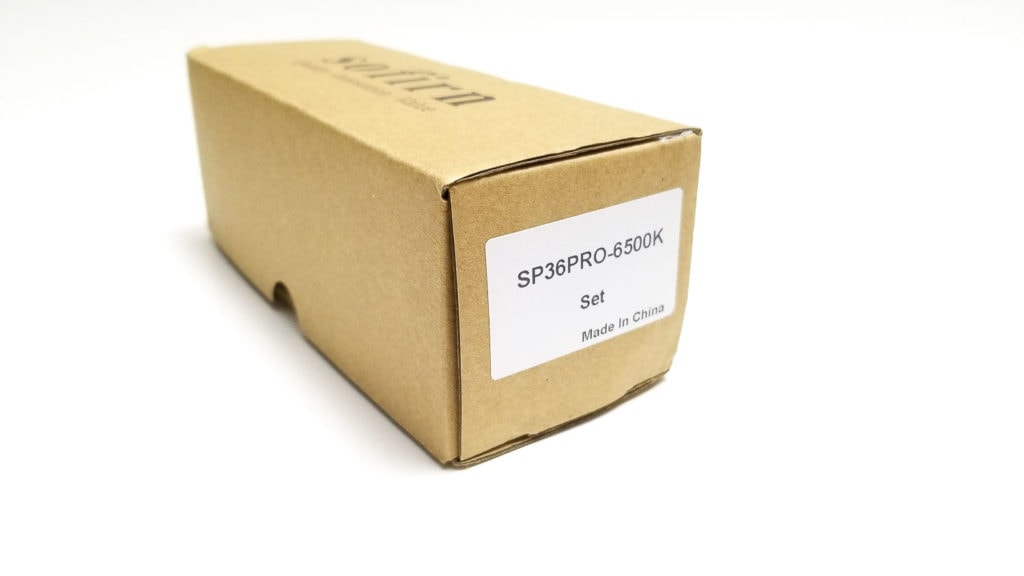
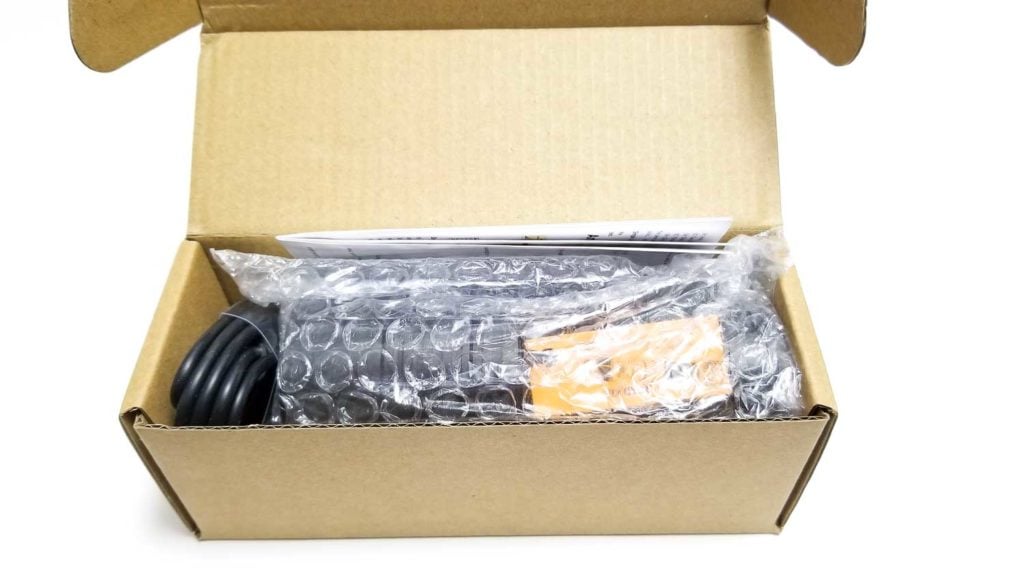
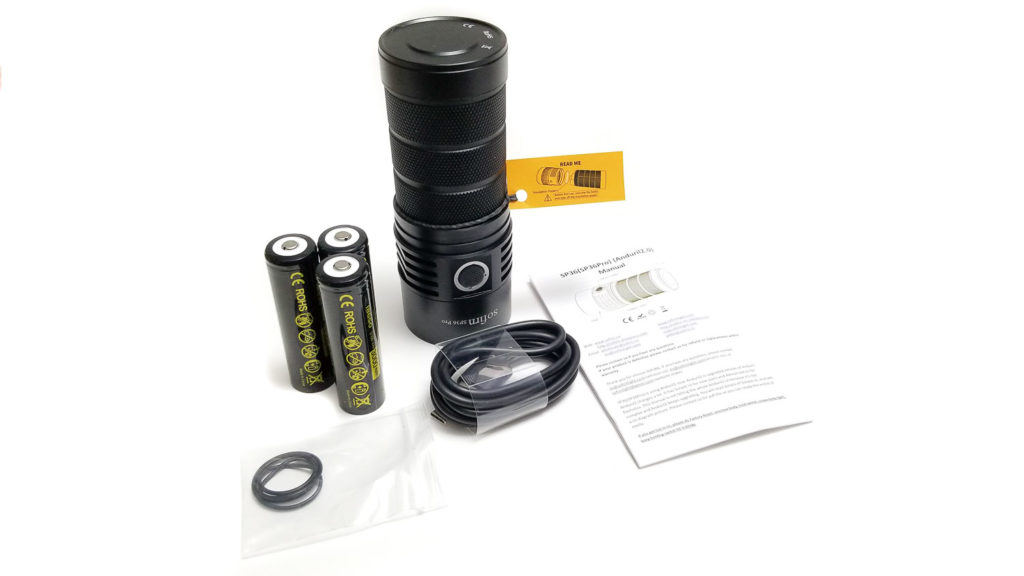
Flashlight in use
The SP36 Pro is based on the ‘soda can’ form factor, and with three 18650 cells in parallel, the body is a little slimmer than the Q8 or similar 4×18650 lights. It’s not lightweight by any means, but comparatively, it’s lighter than similar lights. Despite the girth and weight, I will say it handles nicely. There’s plenty of gripping surface between the smartly-designed battery tube and generous fins on the head. In addition, the balance point is nearly in the center, and that helps limit hand fatigue during prolonged use. The battery tube is covered in diamond pattern knurling that’s very grippy and nicely cut. No issues with handling, but I have large hands so your mileage may vary.
There’s no lanyard hole or attachment points on this new light, so you’re limited to pocket carry, a holster, or pouch. It fits fine in cargo pants or jacket pockets, but smaller pockets would be pretty tight. I would at the very least like to see a means to attach a lanyard like on the Thrunite TN50. The front e-switch is a real gem, one of the nicer ones I’ve come across. It has a silicone rubber cover that’s really grippy and the click action is nice and positive with just the right amount of travel and great feedback. It’s easy to find by feel as well since it sits a little proud from the side and does have LED indicators for finding in the dark. They’re a nice amber color on standby that changes brightness based on the mode selected (and yep, you can adjust the brightness of the aux LEDs in Anduril2), and turn a nice blue, amber, or red (or combination) for charging.
Besides the slightly proud charging port cover, there’s no anti-roll cuts anywhere, so there’s little to stop it from rolling off an uneven surface. Tail standing is no issue at all thanks to the flat tailcap, and with a diffuser it would make an excellent lantern for emergency lighting.
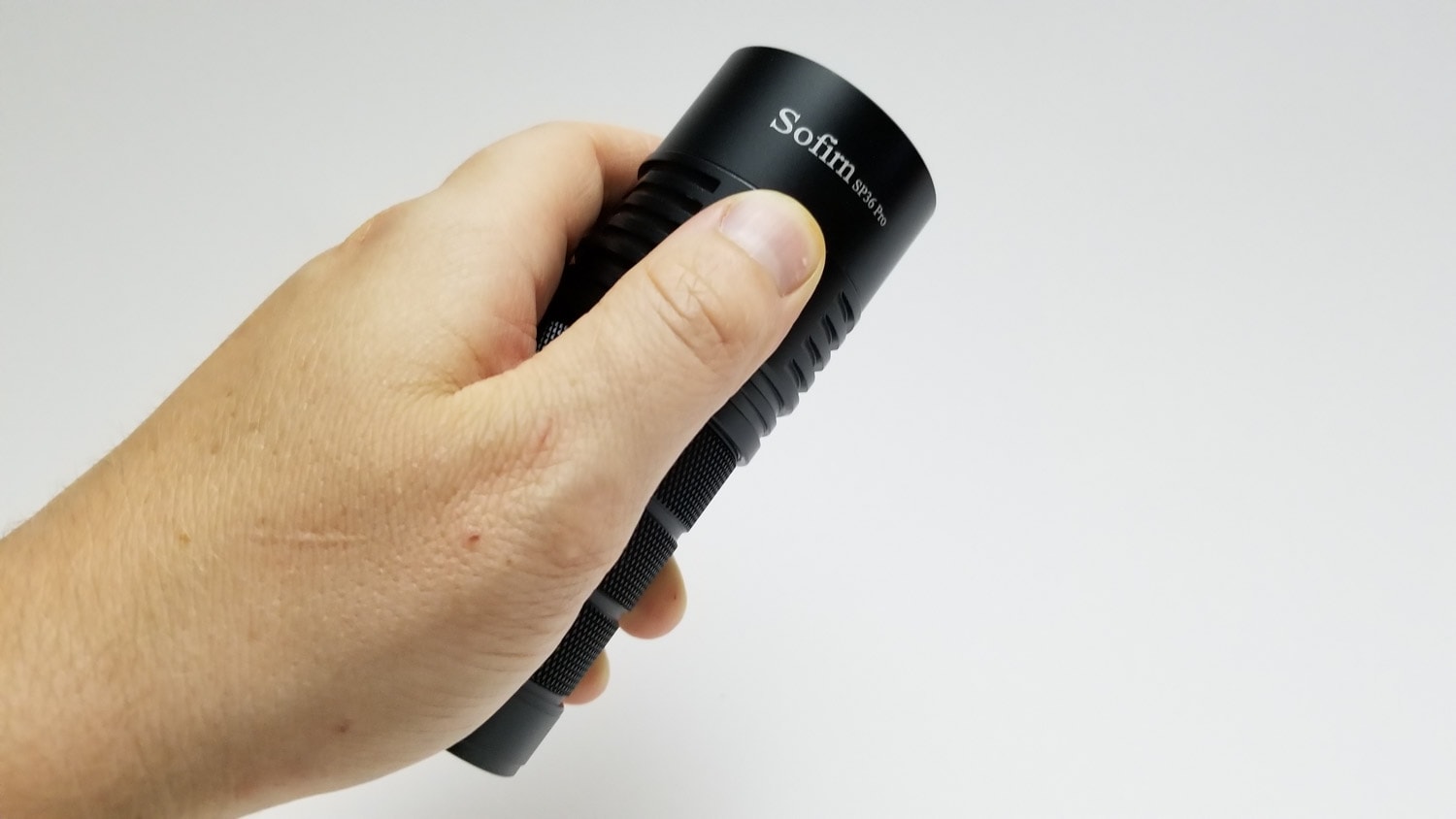
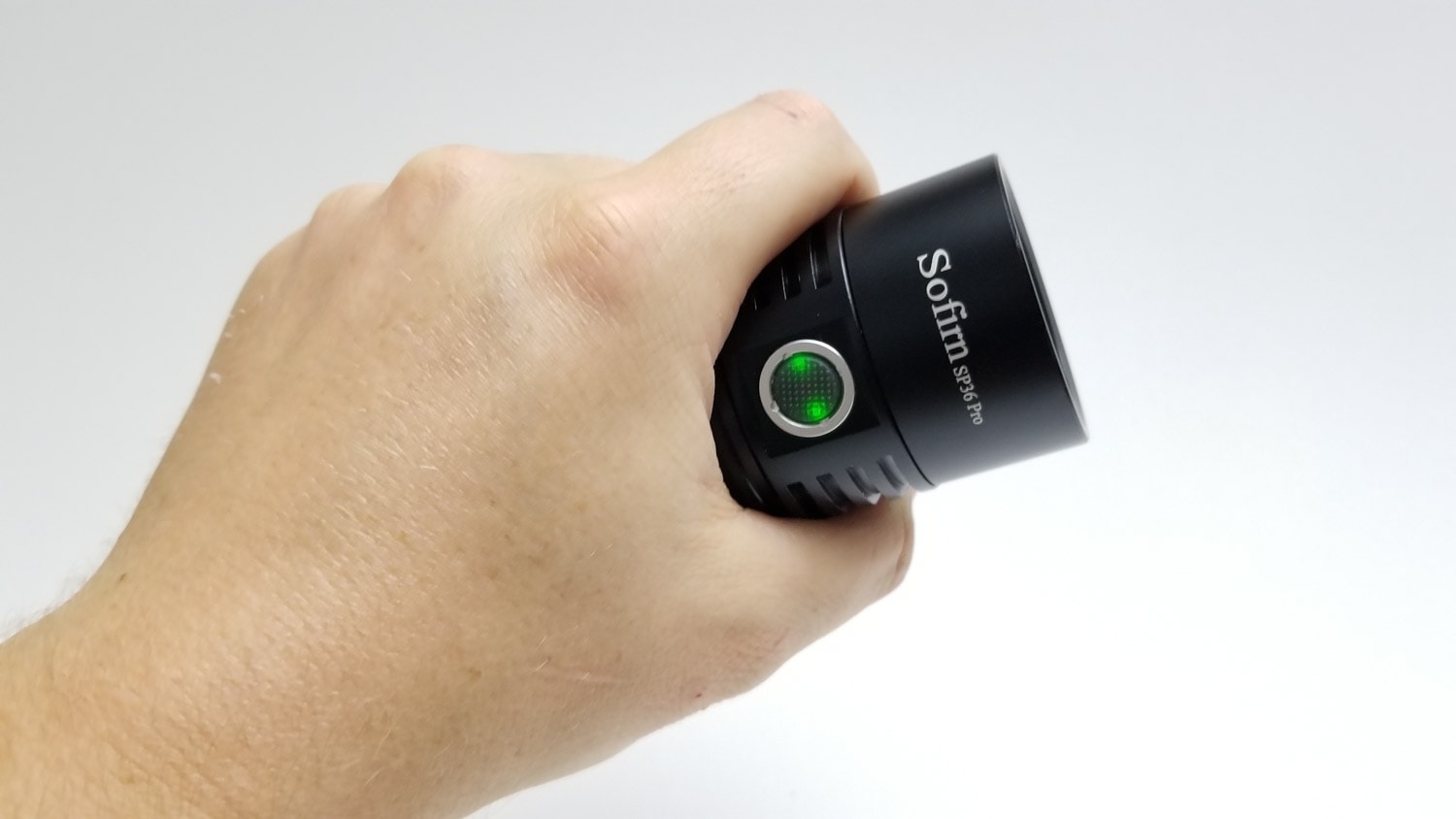
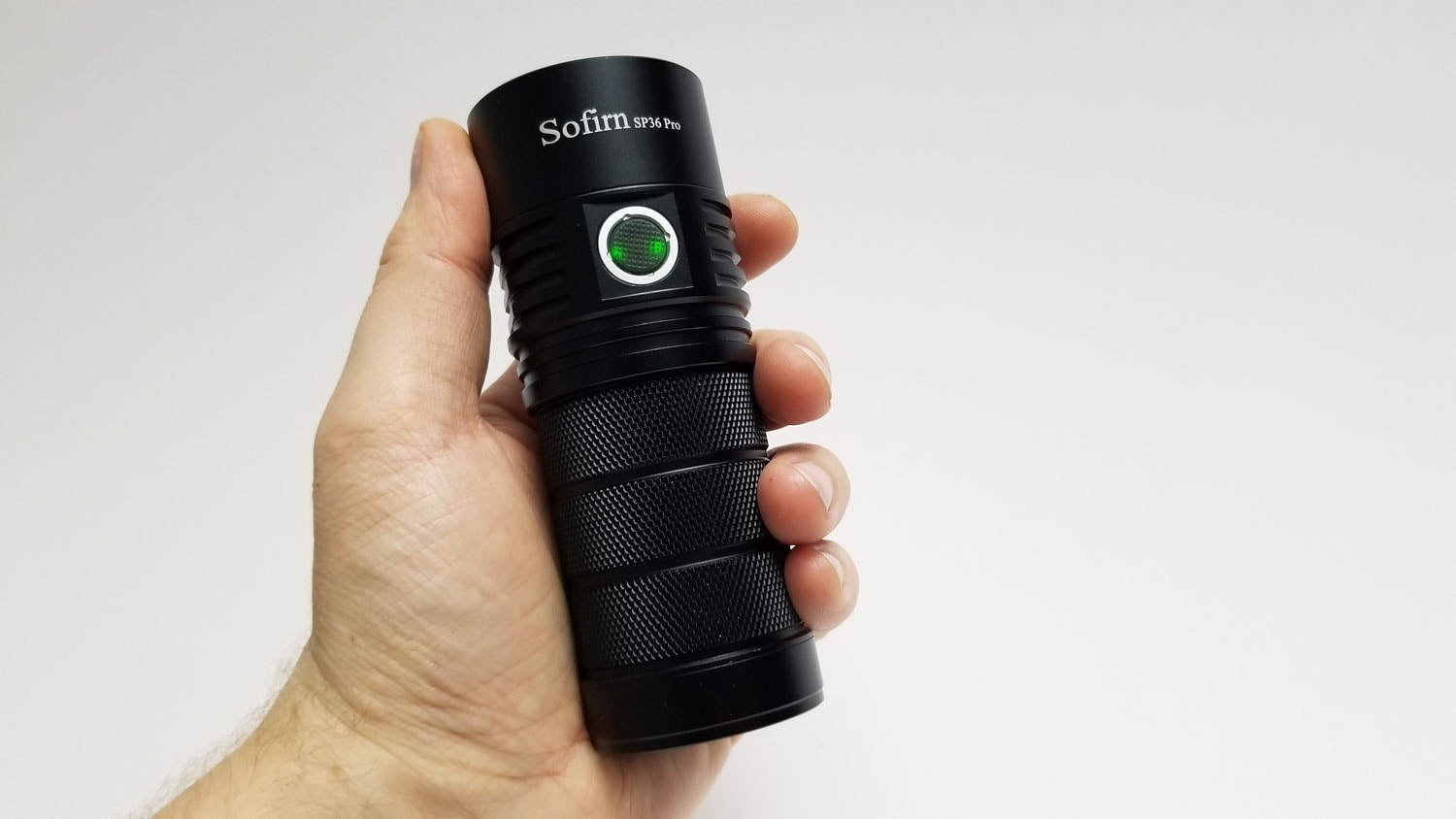
Build Quality, and Warranty
Sofirn’s lights bridge the gap between budget and midrange, so they’re not super cheap, nor what I consider expensive, and instead represent a great value. The Sofirn SP36 Pro Anduril2 sells for just $53.99 with batteries direct from Sofirn ($50.99 without batteries). To put that in perspective, nowadays when $53 doesn’t get you dinner and a movie for two or a tank of gas, this is a great deal.
The build quality is perfectly acceptable for the price and the machining is well done. In fact, it’s better than the last SP36 I reviewed. That light had mildly sharp edges all over the head, so it’s nice to see extra finishing on this light. The silk screen text is sharp and contrasts nicely also. There are no major tool marks or machining defects to be found and the parts all fit together and lined up with no gaps or odd angles. The finish is also well done, and it’s the same decently tough semi-gloss type III HA I’m used to from Sofirn, and I didn’t notice any bare spots, knicks, dings, or coverage issues.
The SP36 Pro can be easily disassembled, and this is what sets a true enthusiast light apart from a consumer-grade flashlight. The bezel, tailcap, tail spring PCB, battery tube, reflector, MCPCB, driver, and switch PCB are all easily accessible and removable. I had no trouble unscrewing the bezel, and getting the driver out is as easy as screwing the switch button bezel with some needle nose pliers or snap ring pliers and finagling out the switch PCB. Although the driver and switch PCB are held on with a little bit of weak glue, it’s not hard to defeat and everything else comes apart without much effort.
The reflector is held to the integrated shelf by some screws, and the MCPCB is also screwed down for an excellent thermal interface. The LED’s can be swapped for any 5050-size emitter and although the firmware is now the bees-knees Anduril2, you can still reprogram or reflash to your heart’s content. The springs in the tail are gold-plated and decently thick, and the driver’s positive side has a brass ring for the positive battery contact. The threads are very nice rectangular cut deals and look very durable. They were adequately lubed also and pretty smooth. Sofirn puts o-rings in all the right places: One sealing the tailcap, one sealing the head to the battery tube, and two in the bezel. The rubber flap sealing the USB port is nice and tight, and I noticed it made a pfftt noise when opening it up after replacing the battery tube. This is good enough for an IPX8 rating, so it should be good for temporary immersion at the least.
Sofirn’s warranty is pretty decent, but your mileage will vary depending on where you bought your light from. From Sofirnlight.com: If your Sofirn product has any defect as the result of the materials or workmanship we want to make it right! Within 30 days of purchase: Contact the original seller for repair or replacement. Within 2 years of purchase: Contact Sofirn for repair or replacement. This warranty does not cover normal wear and tear, modifications, misuse, disintegrations, negligence, accidents, improper maintenance, or repair by anyone other than an Authorized retailer or Sofirn itself. Batteries are currently under a 1 year warranty.
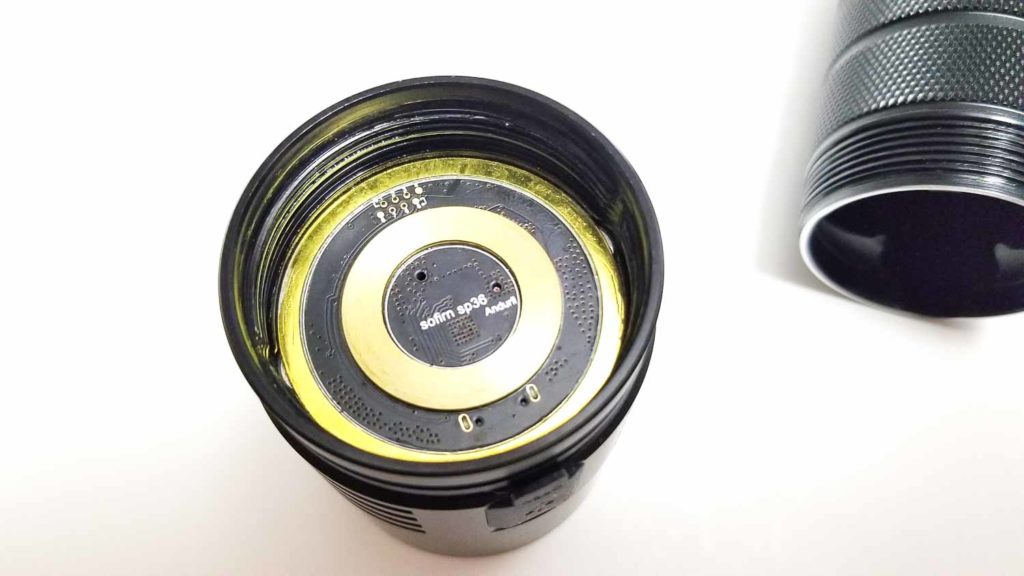
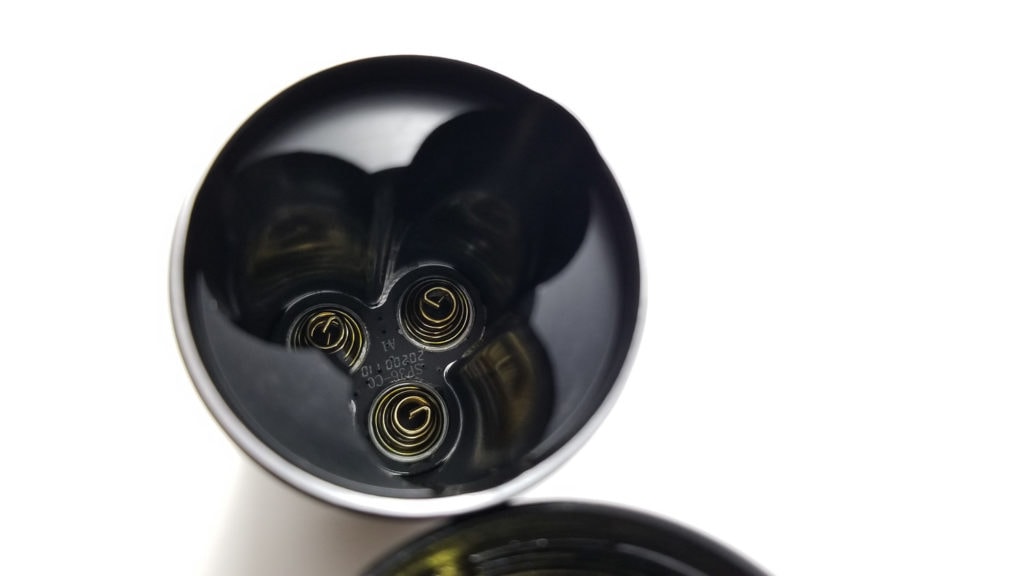
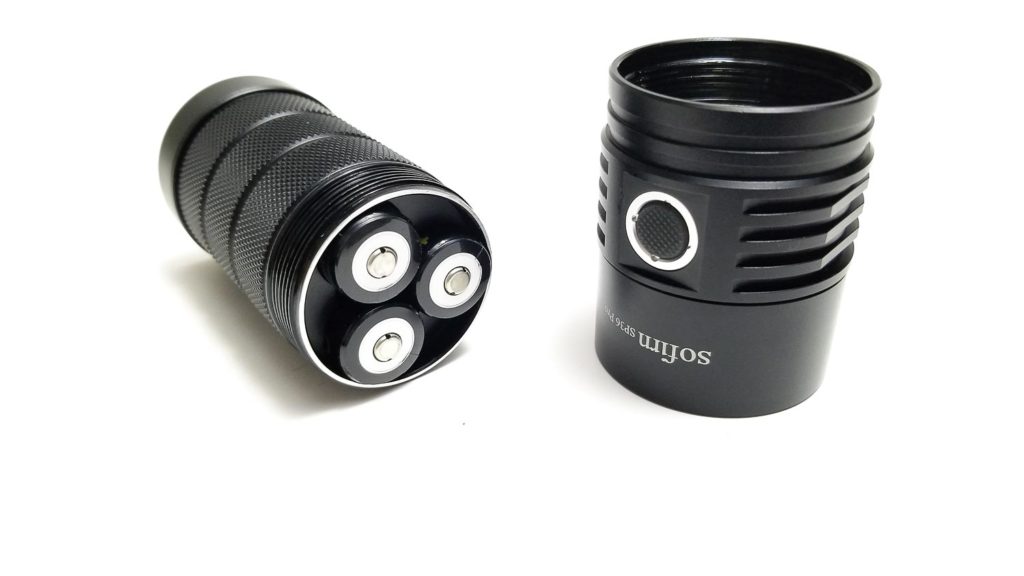
LED, Lens, Bezel, Beam, and Reflector
The SP36 is a quad emitter light, and like the previous model, the Anduril2 Pro comes with the Luminus SST40 and that’s fine because I really like the SST40. It has a low forward voltage, good efficiency, and when driven smartly can produce 2000+ Lumens. This is a 5050-footprint 3 volt LED, and is available in 5000K or 6500K CCT. My sample features the 6500K variety. Not my favorite tint, but it should get pretty bright.
The LEDs are perfectly centered in their respective reflector cups in the flawless quad SMO (smooth) reflector array. It’s topped with a decently thick toughened mineral glass lens with AR coating. It’s set a few millimeters behind the non-crenulated bezel for protection from drops.
The beam is about what I expected, with the typical quad reflector “flower petal” shape, but it’s not at all obtrusive and only noticeable up close on white walls. For this light, Sofirn must have tweaked something in the reflector because the bright ring artifact present in the last SP36 Pro I tested is nowhere to be found in this model. I ran it against the older light on a piece of white paper with both lights the same distance away, and you can easily see the much cleaner beam of the Anduril2 version. The beam still features a defined hotspot and decent throw with generous side illumination. Overall this is an extremely useful beam. The 6500K emitters aren’t high CRI by any means and aren’t my favorite tint, but that’s not what this light is about, right?
The Opple Lightmaster 3 showed the CCT at 6600K and 67 CRI on stepped mode 6. The duv value is 0.0059. Compared to the 5000K version’s 5100K and 68 CRI with a duv value of 0.0009.
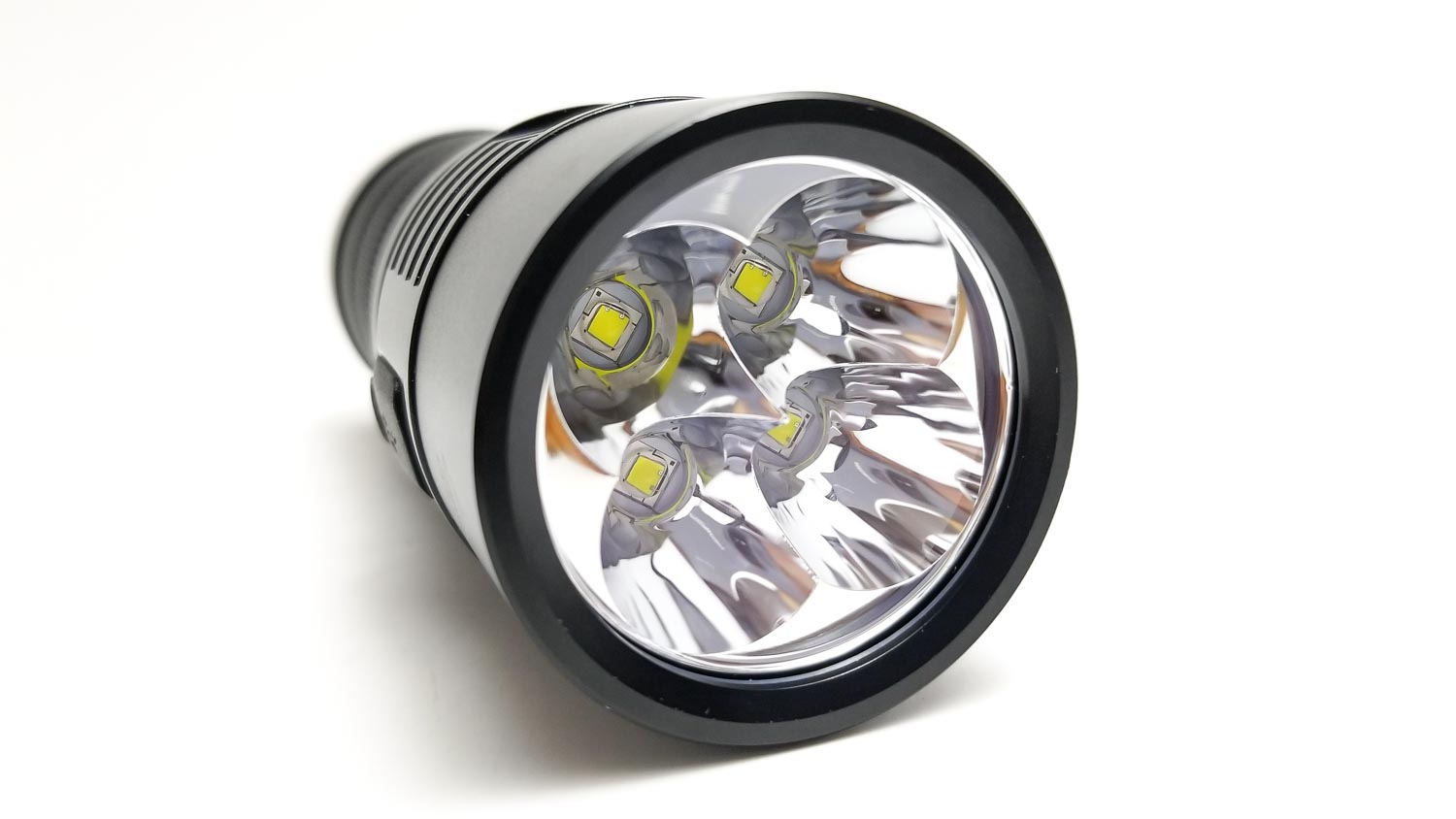
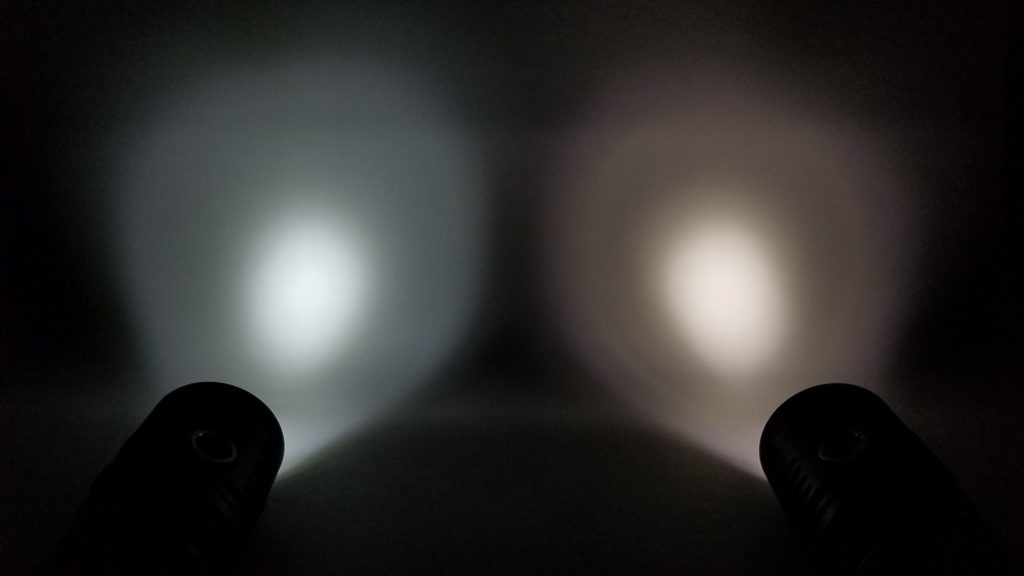
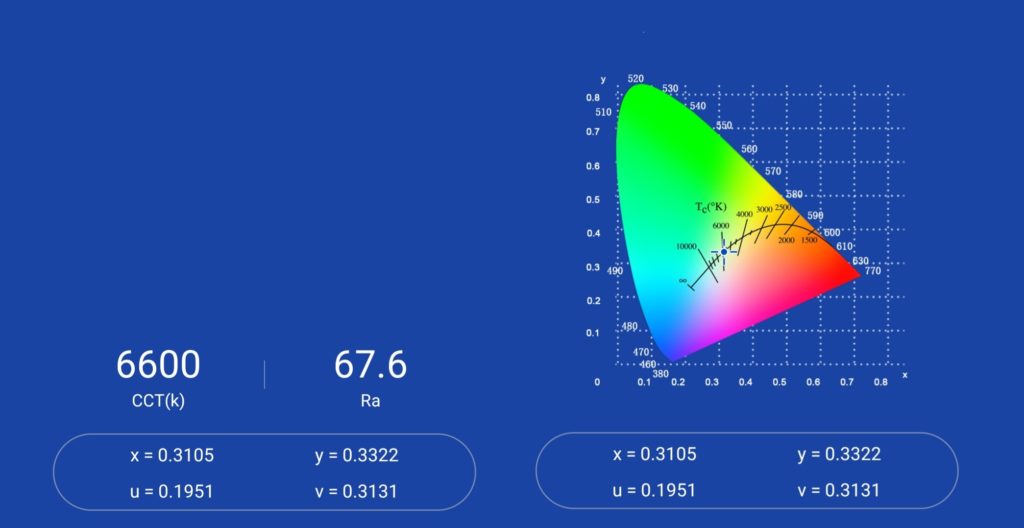
Dimensions and size comparison
- Head diameter: 5.0 cm / 1.96 inches
- Overall length: 12.67 cm / 4.98 inches
Weight:
- Without batteries: 298.3 grams / 10.52 oz.
- With three 3000 mAh 18650 cells: 435.5 grams / 15.38 oz.
Aside from being heavier by 1.25 grams, the Anduril2 version is identical in size to the original Pro.
Flashlight comparison
Group 1 left to right: Skyray King, Sofirn SP36 Pro Anduril2, SP36 Pro, Thrunite TN50, can of chili (who doesn’t like chili?)
Group 2 left to right: WildTrail WT3M, Astrolux MF01 Mini, Imalent R30C, FireFlies E07 2021, Sofirn SP36 Pro Anduril2, Astrolux FT02S, Nightwatch NI03 Valkyrie
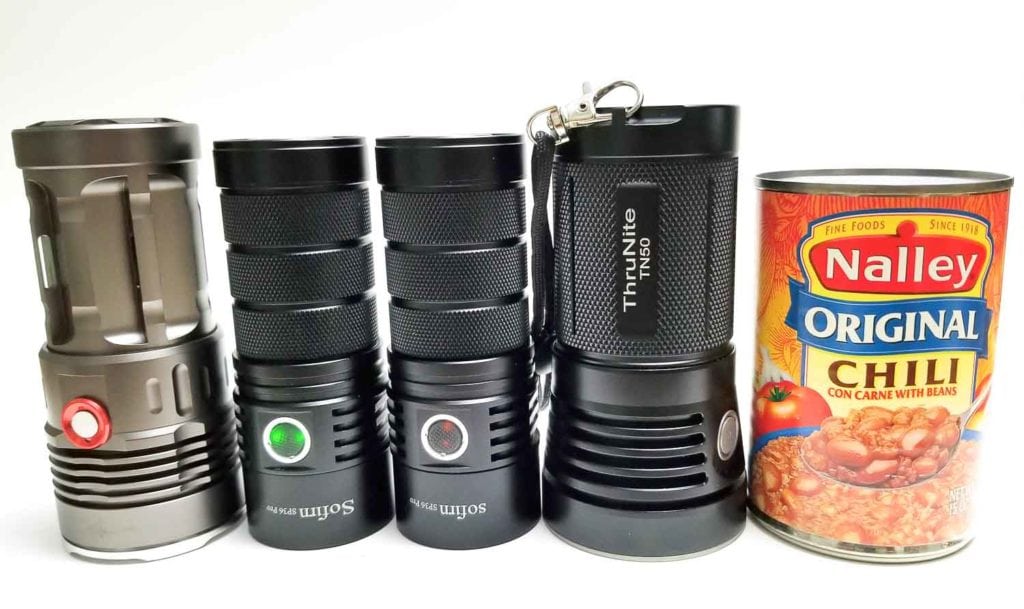
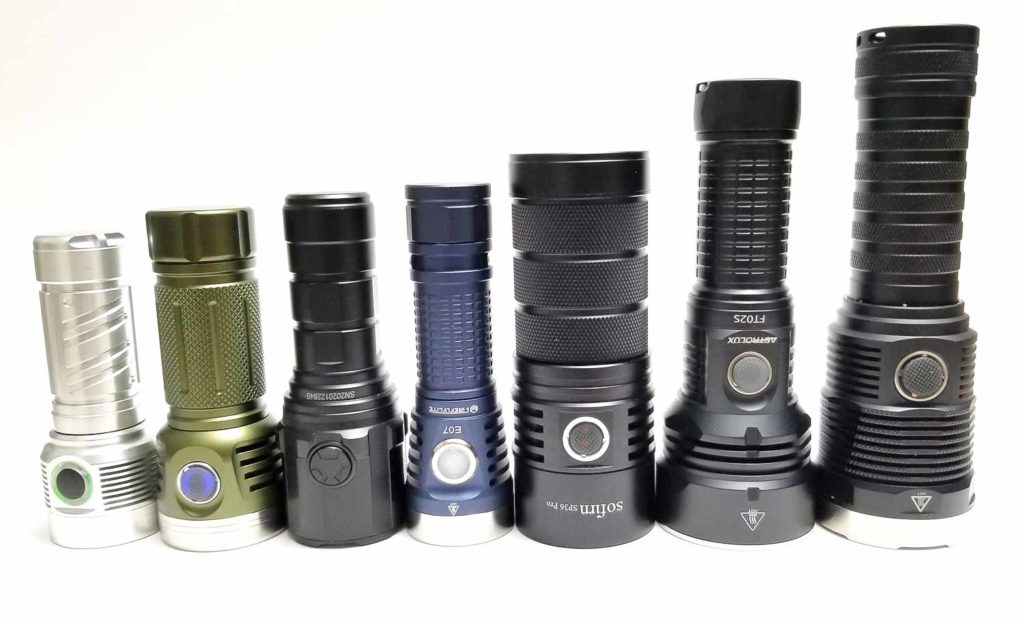
Driver & User Interface:
I suspect the SP36 Pro Anduril2 uses the same FET+7135 driver design, but there’s probably a brand-new driver in this light, evidenced by new traces and flashing pads on the back. This makes sense because Sofirn says they added PD to this version on both the charging and power bank (of course I’ll test that). Since it’s a FET driver, performance is largely dependent on the battery you’re using. High drain batteries will give much higher output, but it will only be noticeable once the FET kicks in in the higher modes (ramping or stepped).
The main feature of this light is of course the addition of Anduril2 UI. My first exposure to Anduril2 was with the Lumintop FWAA, and to be honest, I am not a huge fan of this UI because it took the already-complex Anduril and made it, well, more complicated. I didn’t think that was possible, but here we are.
Thankfully, Sofirn includes a very thorough manual, and of course, YouTube and Google are your friends.
Anduril 2 User Interface
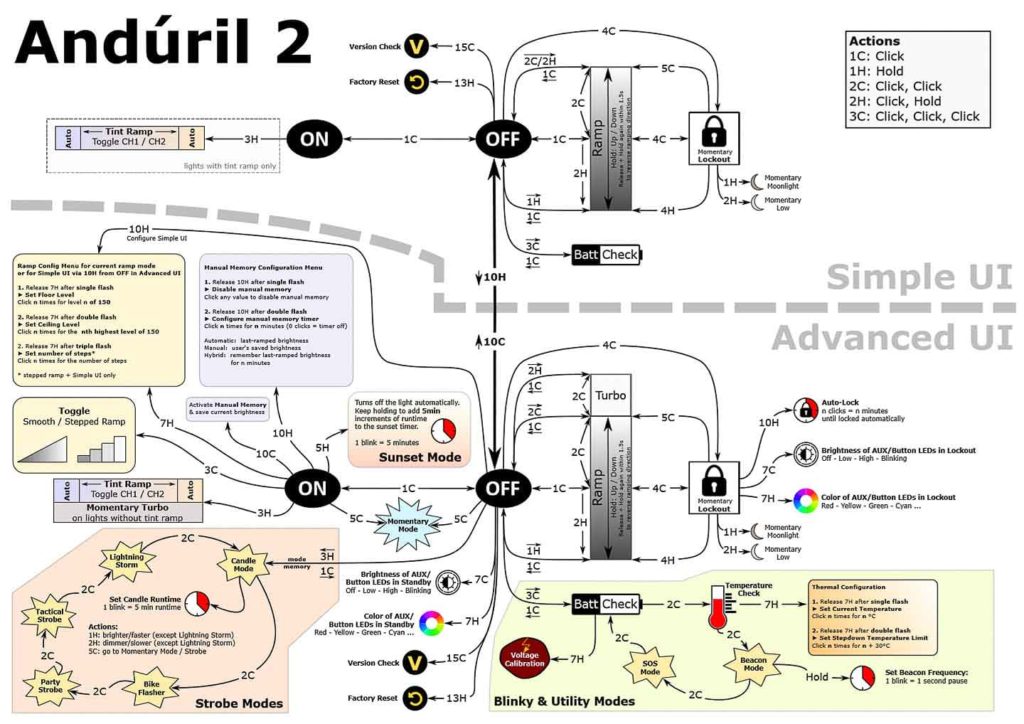
Here is another Anduril 2 image.
And by default, it uses the Simple UI… and here is the UI diagram:
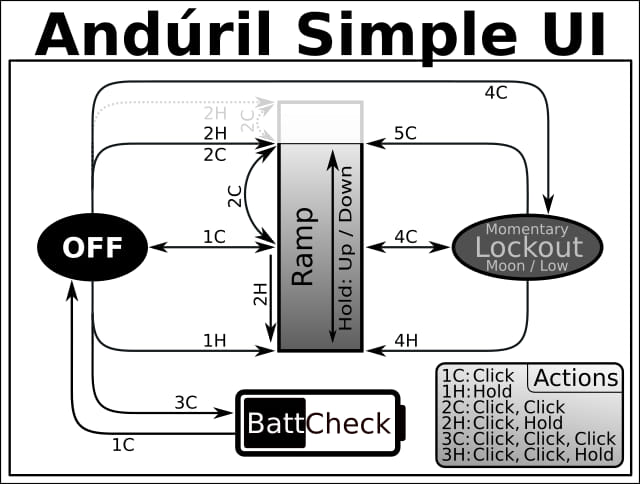
Anduril2 has two UI’s available: Simple and Advanced. The light came with the Simple UI enabled, and I think it’s kind of a misnomer because it’s still a little complicated for a first-time user. However, those familiar with the original will pick it up pretty quickly. Simple UI is missing some of the familiar features present in the original, namely the special blinky modes, temp check, and thermal configuration (those are present in the Advanced UI), and there’s no “muggle” mode either. You still get access to smooth ramping (stepped is, you guessed it, only available in Advanced UI), lockout, momentary high, battery check, and some useful lock/unlock modes.
The Advanced UI is appropriately named because it’s, well, advanced and there’s a plethora of options and configurations available. There’s probably way more features than the average user would ever dip into, but it’s nice to know you can tweak things like the voltage sensor calibration for batt check, AUX LED settings, and even configure the auto-lock. I found this to be a pretty useful feature that enables the light to automatically turn off after a certain amount of time if the light is accidentally activated.
Modes: Simple and Advanced UI both have many standard and blinky modes available, but the main modes are stepped and smooth ramping, but stepped ramping is only available in Advanced UI, and smooth is enabled in both Simple and Advanced.
Switch to Advanced UI from Simple: 10 clicks, but hold on the 10th click
From OFF:
- Press and hold: Turns on in either smooth or stepped ramp (depending on which mode is enabled)
- Single click: Turn on in last mode (step or ramp state-again depends on which mode)
- Double click: Ramp ceiling/turbo
- Triple click: Battery check (in Simple and Advanced UI)
- Triple click and hold: Special strobe modes-remembers last used (in Advanced UI)
- Quad click: Lockout mode. In lockout mode you have different options available:
- 1 click: momentary moon (bottom of ramp)
- 2 clicks: momentary (higher floor)
- 4 clicks: turns on in ramp mode
- 4 clicks with a hold: on in ramp mode, lowest/floor
- 5 clicks with a hold: on in ramp mode, highest/ceiling
- 10 clicks with a hold: configure the lock timeout threshold (in Advanced UI only). This is a new feature for Anduril2, it allows you to set a timeout to the lock, where the light will lock after a pre-set elapsed time.
From ON:
- Press and hold: Ramp up (depending on the mode)
- Single click: Turn off
- Double click: Ramp ceiling/turbo
- Double click and hold: Ramp down
- Triple click: Toggle between smooth and stepped ramping (in Advanced UI only)
- Quad click: Lockout mode (see above for the lockout options)
Mode memory:
- Yes, memorizes last on state setting either smooth or stepped ramping, but does not remember blinkies
Low voltage warning:
- Yes, when in operation, the light steps down brightness gradually until turning off when the cell is around 2.9 volts.
Strobe/blinkies
- Yes, many! The blinkies are accessible from off with 3H (click click click-hold) in ADVANCED UI only. You switch between strobe modes with 2 clicks:
- Candle mode
- Bike flasher
- Party strobe
- Tactical strobe
- Lightning storm
Lock-out mode:
- Yes. In Simple or Advanced UI, lockout is accessed by 4 clicks from on or off. 4 clicks to unlock. The lockout enables momentary operation in the moon mode, however, 2H (click click-hold) enables low mode. There are other lockout modes available (see the diagram).
Temp check and thermal calibration mode
- In the first version, you could do both the ambient temperature sensor calibration and thermal ceiling at the same time, but in Anduril2, it’s a little different. When in temp check, click 7 times and hold on the 7th to enter the thermal configuration. To configure the ambient temp, wait for the first flash and then set the ambient, but once you’ve done that, you need to go back to the temp check and click 7 times, hold on the 7th, this time, don’t let off the button. Wait for the 2nd blink, and then you can set the thermal ceiling.
Additional info
Anduril2 is a very comprehensive UI and has a ton of configurability, but I wished they hadn’t moved some of the most useful functions to the Advanced UI. Also, a novice user could potentially melt something or burn themselves even in Simple UI since the top of the ramp and the last stepped mode is basically Turbo (or max output). However, I think a novice could totally get the hang of the simple UI after some finagling. The LVP works fine down to 2.9’ish volts with the light getting dimmer and dimmer before turning off as expected. Not surprisingly, the thermal calibration was off from room temperature (27 vs. 22 C), but here’s a tip to set the calibration and the thermal ceiling. You can set it to the pre-calibrated level (or if you manage to muck up the light with your tinkering) by doing a factory reset.
Anduril 2 factory reset:
Loosen the tailcap, hold down the switch button while tightening the tailcap, and keep holding for 4 seconds or so. You will get some odd blinking and a full power burst to indicate the reset was successful. Thermal calibration for Anduril2 is a bit different from standard Anduril, and can only be done in Advanced Mode. Make sure the light is cooled to ambient temperature for this, then 3C from off to get into the Utility/Special Modes menu, 2C to get to the temp check and it will blink out what it thinks the ambient temp is. If it’s off, then 7H (7 clicks with a hold on the last click) to get to the calibration menu where you can set the ambient temperature like normal. To get to the thermal limit setting, after the bink set for ambient calibration keep holding the button down for 2 seconds until another blink set, then you can set the thermal limit.
Batteries & Charging
The battery configuration consists of three 18650 size batteries in parallel. The design of the driver is generally conducive to button top cells, and no surprise that Sofirn recommends them. The kit came with some of Sofirn’s button top 3000 mAh 18650s, and these have proven to be pretty decent cells for about 10 amps. I tried some solder-blobbed Sony VTC6 flat top 18650s and they fit fine.
Note that protected cells or ones with integrated charging probably won’t work here due to the length, but you wouldn’t need to use protected cells anyway because Anduril2 has LVP built into the firmware. For yucks, I tried a protected button top Acebeam 18650 with USB charging and at 71 mm long, it was too long.
This light, like the original, features USB type C charging, but Sofirn once again flexed their postulative muscles and gave this light USB PD (power delivery) charging and power bank functionality. This is huge because one of my gripes with the prior light was the slow charging. The last light managed 1.8 amps max, but this one does 2.7 to 2.8 amps at 5 volts with mostly charged batteries, so considering losses in the buck charging circuit, let’s call it 5V 3A. Even though all 3 cells have to share that current, it’s theoretically 1 amp per cell, which cuts the charge time from 5+ hours to under 4. Hey, I’ll take it, and it saves you from buying a charger. I tested the power bank and it managed 5 volts and about 1.88 amps, which is awesome, and with about 8.5 Ah of available juice onboard, you should be able to charge a cell phone a couple times, and yes, I couldn’t resist and charged the old SP36 Pro with the SP36 Pro. I also charged my Galaxy Tab, phone, and some flashlights with no issues. USB C to C and A to C cables both work fine.
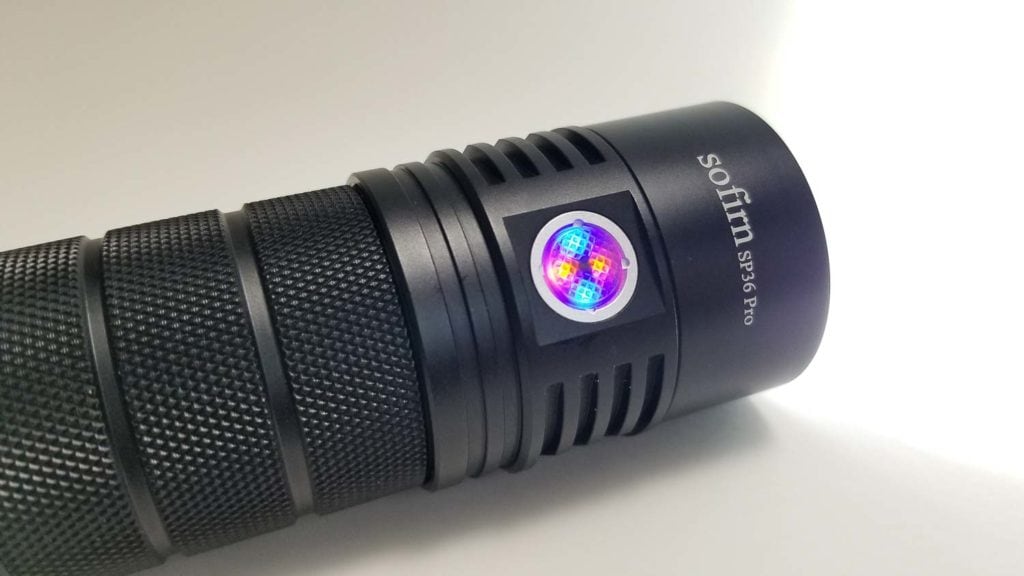
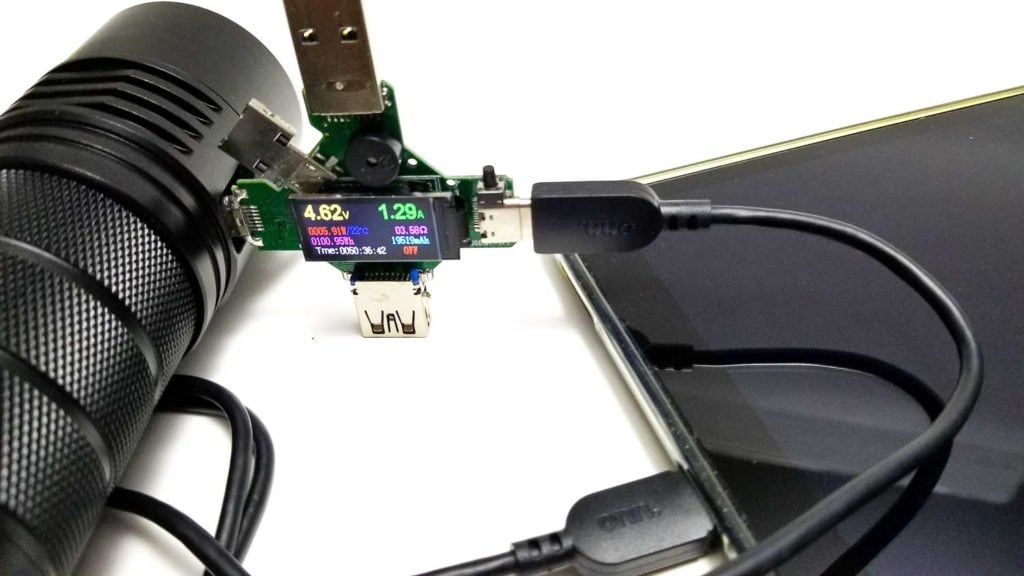
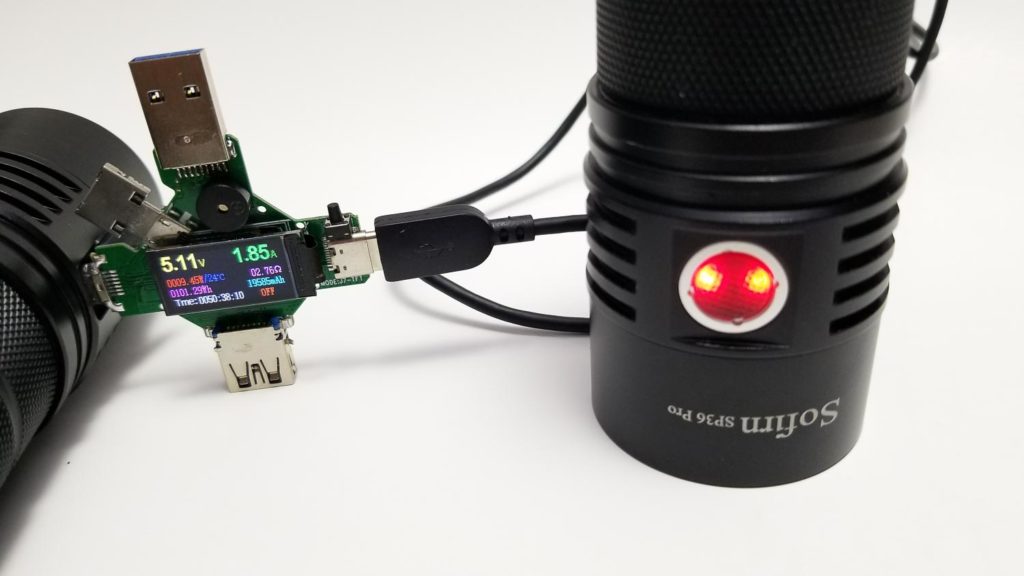
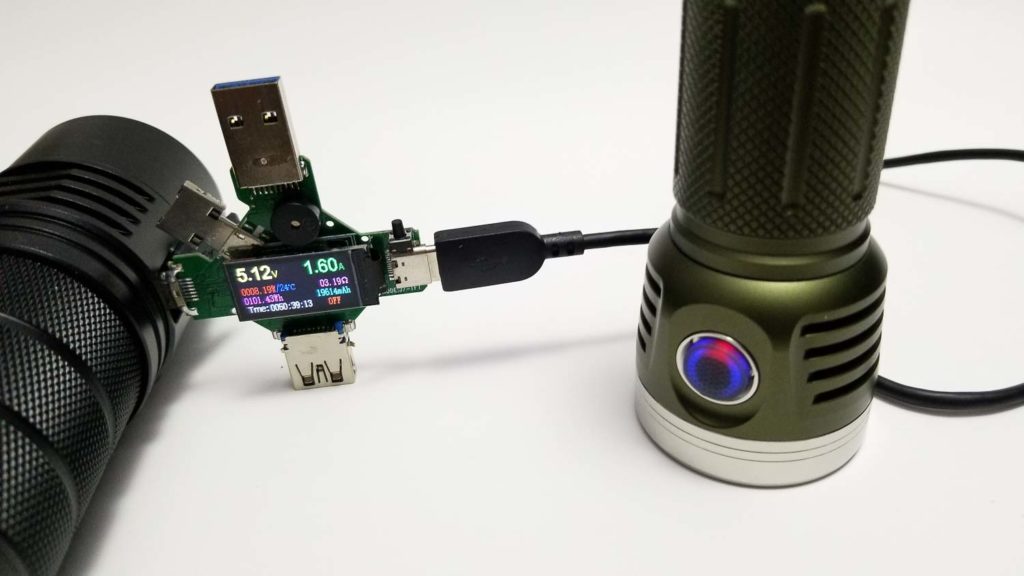
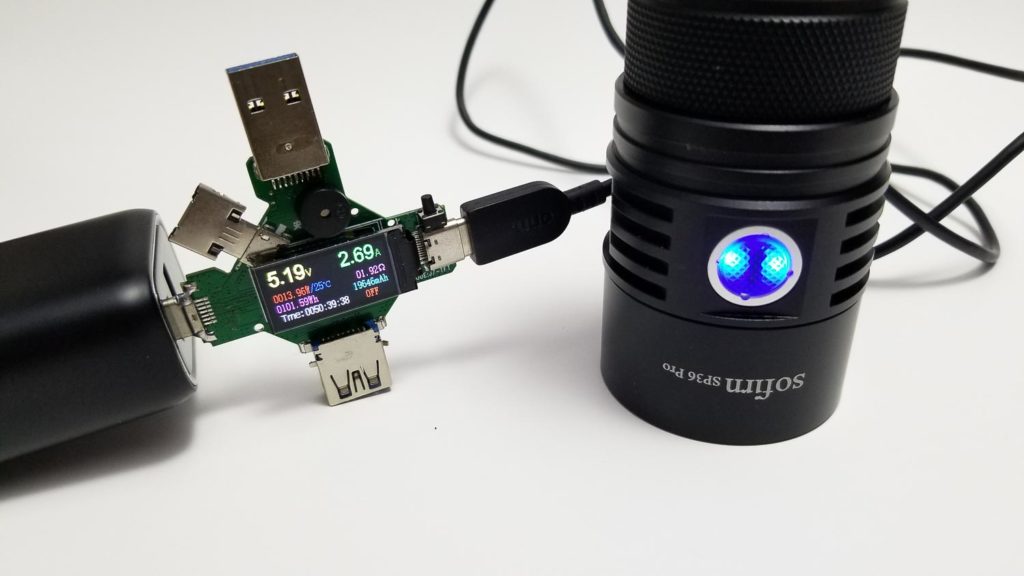
Performance
Lumen measurements
Although this light is sporting a new driver, it’s still the same design, so I doubt that will translate into any meaningful performance gains, but here we go. Lumens were measured using my home made 30 cm integrating sphere that’s been calibrated with several lights of known output including a Makkua-calibrated Convoy S2+. I use a Digi-Sense 20250-00 datalogging luxmeter.
I used the included fully-charged 3000 mAh Sofirn batteries for the tests. It’s no secret that measuring amps on this type of light is tough (and sparky). I ended up gluing a single battery into position against the driver’s positive contact with hot glue to hold it steady and used a loop of 12 gauge wire between the battery negative and ground contact ring on the back of the driver. I used my clamp meter and measured Simple mode’s default 5 stepped modes.
| Mode | Amps at start | Specs | Lm @turn on | Lm @30 sec | Lm @ 10 min |
|---|---|---|---|---|---|
| L1 | N/A | ? | 1 | 1 | – |
| L2 | 100 mA | ? | 53 | 53 | – |
| L3 | 1.5 A | ? | 506 | 506 | 490 |
| L4 | 5.9 A | ? | 2,407 | 2,324 | 1,743 |
| L5/Turbo | 13.8 A | 8,000 lm | 5,359 lm | 5,146 lm | 1,162 lm |
Like other lights running Anduril, there aren’t any Lumen specs for the SP36 Pro Anduril2, other than a maximum brightness of 8,000 Lumens. No surprise that my numbers are way off. The last SP36 Pro I tested didn’t meet the factory specs either, even with Sony VTC6s on board. This light? Even on fully charged VTC6s I got 6142 Lumens at turn-on. Chalk it up to variations in batteries, FET quality, etc.
Parasitic drain:
- 2.1 µA
Runtime graph
I tested the light in my 30 cm integrating sphere calibrated using several lights including a Makkua S2+ with the Digi-Sense 20250-00 datalogging luxmeter with the included fully-charged 3000 mAh batteries. I tested stepped modes L3 to L5/Turbo in Simple mode. I set the thermal ceiling to 70 C (max) and calibrated the thermal sensor to an ambient of 23 C.
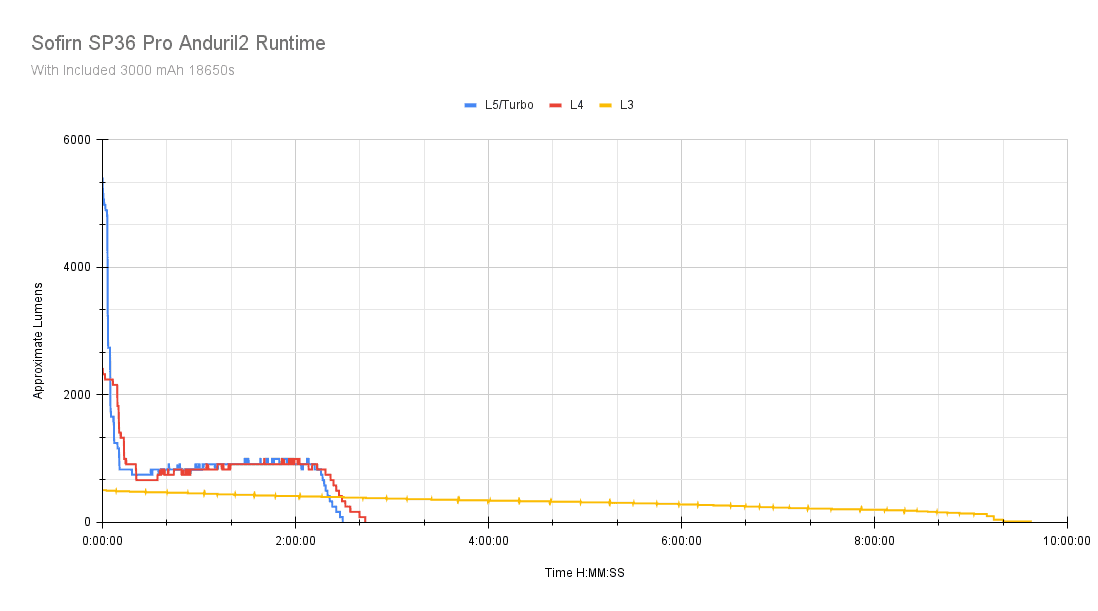
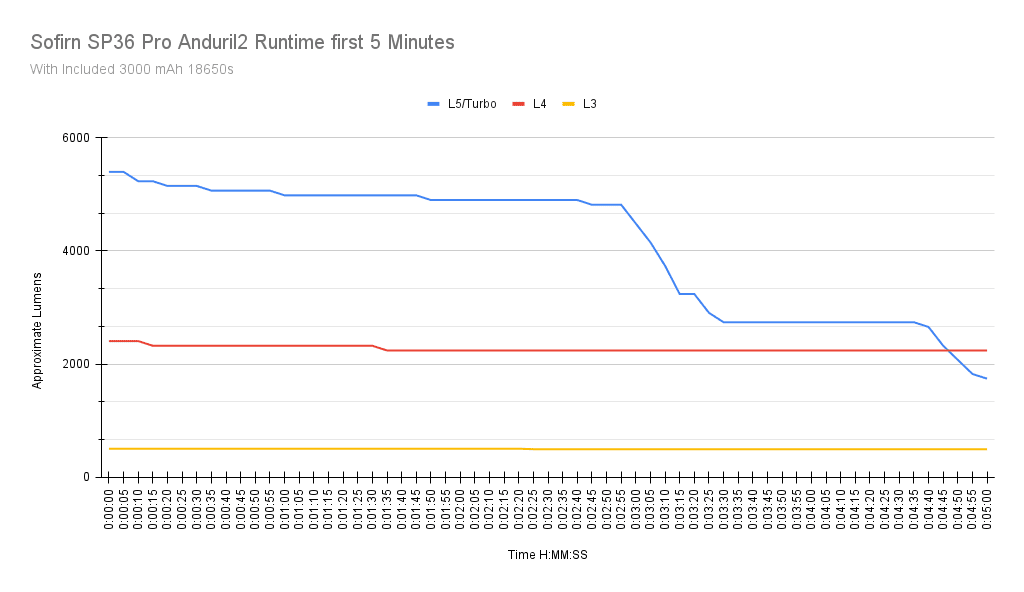
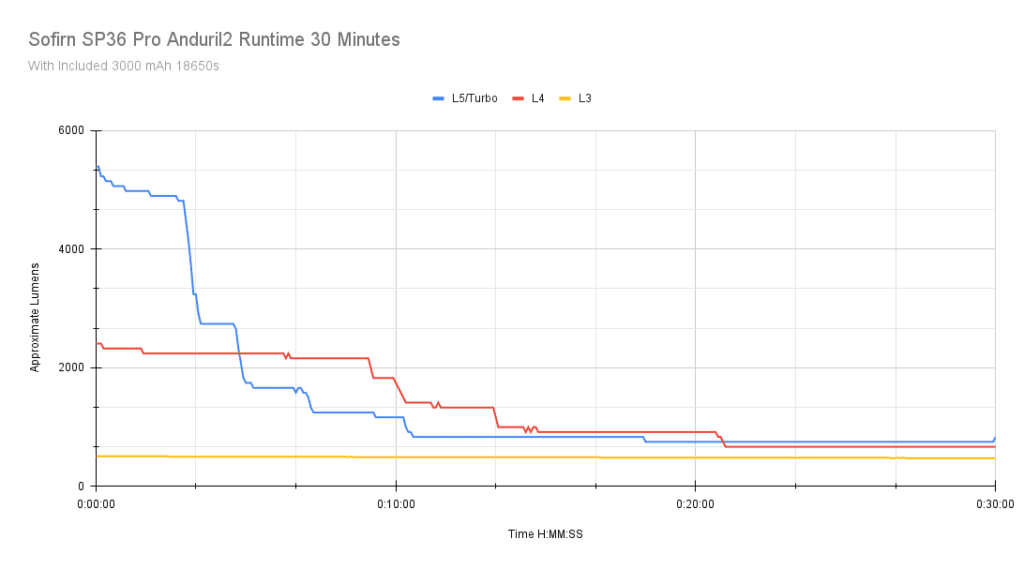
L5 (or Turbo) started at a hair under 5400 Lumens, way down from the factor spec 8000. The output was pretty stable for the first 60 seconds, with good sustained output, managing 5000 Lumens or better until the 55 second mark. From there, it held 4000+ Lumens for over 3 minutes, with gradual step downs as the UI throttled the output when the 70 C thermal ceiling was reached at around the 2 minute 50 second mark. From about 3 minutes 30 seconds on, we see typical FET driver behavior, with the output decreasing as the cells drain, but it still managed better than 1000 Lumens for over 10 minutes. However, it’s too hot to handle after 5 minutes, with the body reaching 61 C. For the next 2 hours, the output stays around 830 to 990 Lumens, until the 2 hour 28 minute mark when in typical Anduril fashion, LVP drops the output way down. I ended the test at 2 hours, 29 minutes.
L4 was a facsimile of L5, not surprising since it’s running off the FET as well starting at 2400 Lumens, and holding better than 2000 Lumens for over 9 minutes, and better than 1000 Lumens for over 13 minutes. For the next 2 hours, the output throttled with temperature changes between 774 and 913 Lumens, until 2 hours 39 minutes when LVP pulls the output down to near zero and I ended the test. L4 ran about 11 minutes longer than L5. Heat was of course more manageable, but only until about 4 minutes in when the heat hits 60 C, and by 5 minutes it cannot be held with bare hands at 68 C.
L3 was still getting into the FET, but not nearly as much as L4 and 5. This mode ran about 1.5 amps, so the runtime was pretty long and stable mainly due to the fact it didn’t heat up! L3 started at 506 Lumens and held that for about 2 minutes, with imperceptible drops in output over the next 6 and a half hours. It’s wasn’t until 6 hours 40 minutes that the output drop was noticeable at 250 Lumens, and from there it still held better than 200 Lumens for the next hour and 15 minutes. By 8 hours 33 minutes, the output steps to 166 Lumens, then at 9 hours 20 minutes, it’s down to 16 Lumens. I ended the test when the output dropped off the luxmeter at 9 hours 37 minutes. Heat was never an issue, evidenced by a 10 C increase over ambient temperature, peaking 25 minutes into the test.
Overall, performance is pretty much identical to the outgoing Pro, and that’s fine with me. No surprise since the driver is essentially unchanged aside from Anduril2 and tweaks to the charging circuit. No complaints with the thermal management here. Anduril does its job seamlessly, and the LVP works perfectly as well, with the test always ending with the batteries around 2.9 volts. The light was always usable after each test, albeit with considerably reduced output. I test lights with Anduril at the highest thermal ceiling to eliminate throttling as a variable, so your mileage for sustainability will vary based on the thermal ceiling setting.
Throw numbers:
I measured the throw with the Uni-T UT383S luxmeter indoors at 5 meters. I used the included fully charged batteries and tested the 5 stepped modes in Simple UI.
| Mode | Specs | Candela measured | Meters | Yards |
|---|---|---|---|---|
| L1 | ? | 50 cd | 14 | 15 |
| L2 | ? | 500 cd | 45 | 49 |
| L3 | ? | 5550 cd | 148 | 162 |
| L4 | ? | 28,150 cd | 336 | 367 |
| L5/Turbo | 450 meters | 60,050 cd | 490 | 536 |
Sofirn doesn’t list any candela specs for this light other than “450 meters range” on the product page. I got a bit more than that, and I believe it since it’s properly bright and throws pretty good! I have no doubt this would be a pretty stout thrower with some SFT40s in there (hint, hint Sofirn).
Beamshots
I compared the TSP36 Pro Anduril2 with some very high power lights, including the original SP36 Pro (which had the 5000K emitters). I measured these lights for output, so the Lumens figures are mine: Modded Skyray King with 4x 5000K SST40s (5000 Lumens), Astrolux FT02S 4x XHP50.2 (12,000+ Lumens), Astrolux MF01 Mini 7x SST20 (7200 Lumens), Astrolux EC03 3x SST40 (5200 Lumens), Imalent R30C 3xSST70 (8000 Lumens), Thrunite TN50 4x XHP70.2 (18,000+ Lumens), Wurkkos DL70 4xXHP50.2 (11,000 Lumens).
Outdoor pictures: The fence is about 95 meters away.




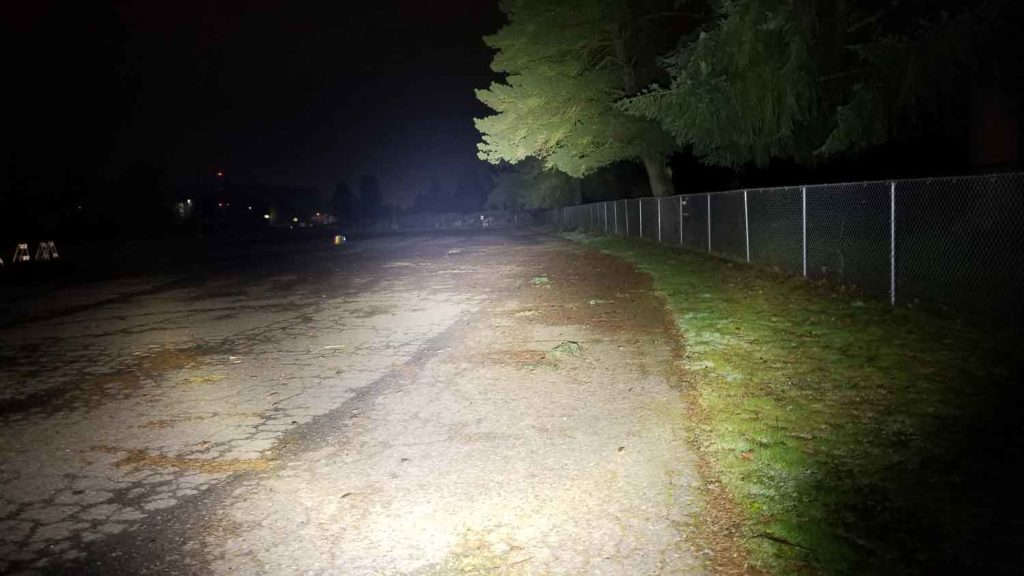
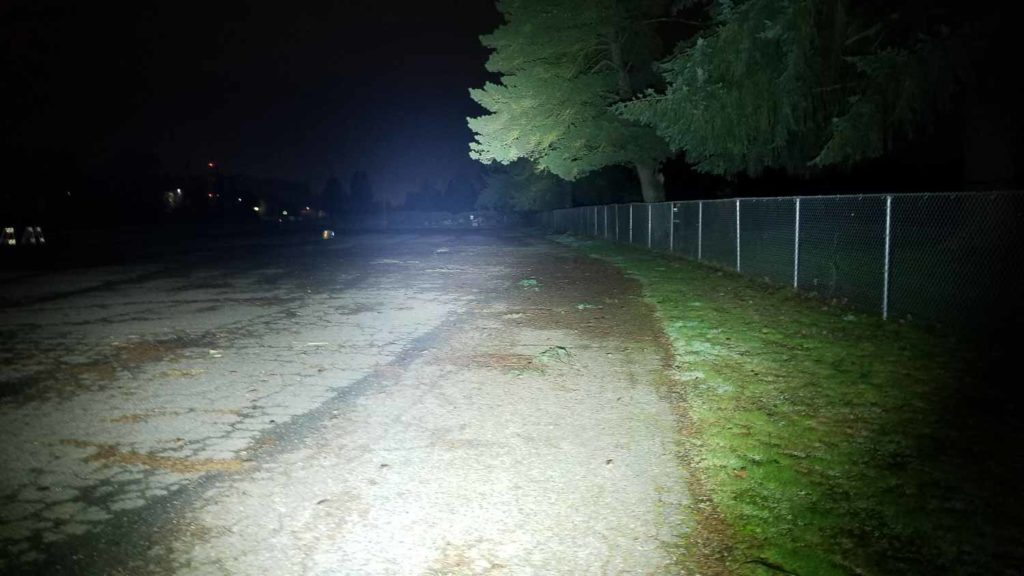

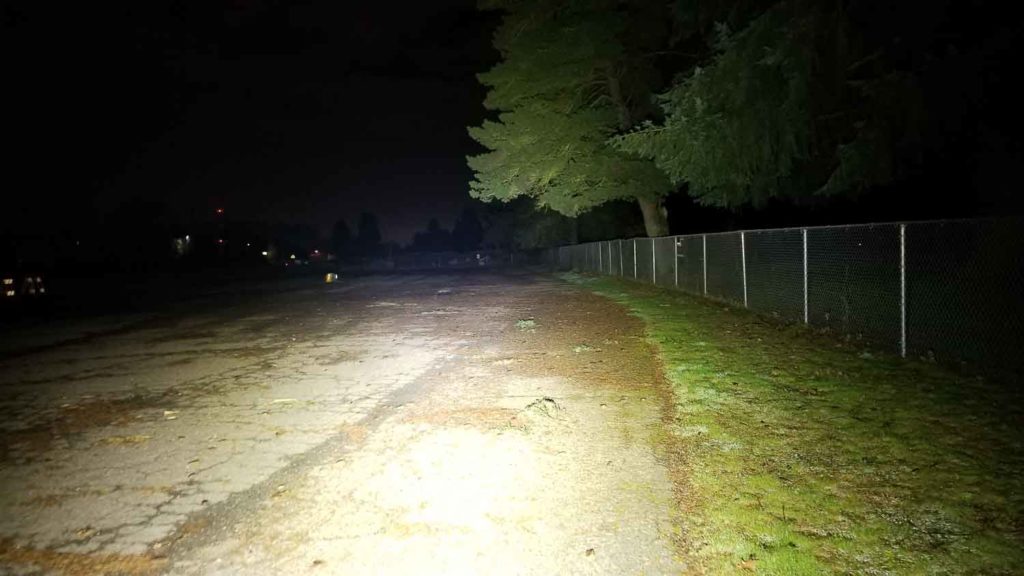

Disclaimer: This flashlight was sent to me for review at no cost by Sofirn. I have not been paid to review, nor have I been holding back on problems or defects.
Final Verdict
Pros
- Solid build quality
- Great value with included batteries
- Nice handling for a can light
- Upgraded charging speed
- Power bank
- Anduril2
- Can be disassembled
Cons
- Anduril 2 is complicated
- No lanyard hole
- Actual output nowhere near factory specs
Explanation on star ratings:
1: Avoid: my phone flashlight would be a better choice – 2: Poor: significant defect or issues; almost unusable – 3: Average: some defects or issues; but still usable 4: Good: recommended (minor issues) – 5: Great: highly recommended

5 stars: ★★★★★
What do you get when you take an SP36, put some SST40s in it, flash Anduril2, add power bank capability and boost the charge current? The Pro 2? Nope, it’s still the Pro, but even so, I like the upgraded 3 amp charging, and I really like the added power bank function so you can put all those mAs to good use. For everyone who was nagging Sofirn for Anduril2 with the SP36 series, well, ask and you shall receive. Now, I’m not a huge fan of these complex UIs, but Anduril2 does a good job with packaging the features and functionality, and there’s a lot of resources to help you negotiate the very busy UI schematic. However, once mastered and properly “wielded”, it’s a hugely functional UI, and there’s currently nothing else that comes close to matching it feature-to-feature. Everything I liked about the last Pro is still here, and the fact that the beam has been cleaned up (albeit no longer neutral white), the machining is tidier I don’t have much to nag on.
The prior Pro’s lone annoyance (aside from the inherently complex Anduril2) is still present since I think it needs a lanyard hole or some way to mount one. That’s a really useful feature for a light like this. The output still doesn’t meet advertised, but not surprising. I’d also like to see a tripod mount and some anti-roll features. However, other than that I can’t fault it much. Even though it hasn’t changed much, this is still a superbly versatile (and affordable), powerful light for a fantastic price. 5 stars for the new SP36 Pro.
Sofirn SP36 PRO discount
15% off coupon code: VSDSCW0P (temporarily available)
1lumen selects and reviews products personally. We may earn affiliate commissions through our links, which help support our testing.